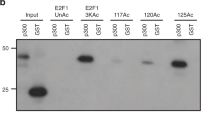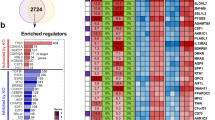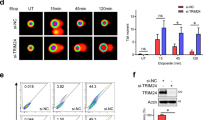Abstract
The hereditary autosomal recessive disease ataxia telangiectasia (A-T) is caused by mutation in the DNA damage kinase ATM. ATM’s main function is to orchestrate DNA repair, thereby maintaining genomic stability. ATM activity is increased in response to several stimuli, including ionising radiation (IR) and hypotonic stress. DNMT1-associated protein 1 (DMAP1) is a member of the TIP60-p400 histone acetyl transferase (HAT) complex, which acetylates histone H4 at lysine 16 (H4K16) to affect chromatin relaxation and modulate ATM activation. Here we demonstrate that DMAP1 is required for both modes of ATM activation. Knockdown of DMAP1 impaired IR-induced ATM activation and consequently resulted in radiosensitivity and impaired the G2/M checkpoint. Moreover, DMAP1 was also required for efficient ATM signalling in response to hypotonic stress. Overexpression of DMAP1 increased IR-induced ATM substrate phosphorylation, suggesting that DMAP1 function is rate limiting for ATM signalling. DMAP1 associated with TIP60-dependent HAT activity, and depletion of DMAP1 reduced H4K16 acetylation in response to DNA damage. Treatment with histone deacetylase inhibitors rescued IR-induced ATM signalling in Dmap1-depleted cells. These results suggest that DMAP1 is a critical regulator of ATM activity and function.
This is a preview of subscription content, access via your institution
Access options
Subscribe to this journal
Receive 50 print issues and online access
$259.00 per year
only $5.18 per issue
Buy this article
- Purchase on Springer Link
- Instant access to full article PDF
Prices may be subject to local taxes which are calculated during checkout





Similar content being viewed by others
References
Chun HH, Gatti RA . Ataxia-telangiectasia, an evolving phenotype. DNA Repair (Amst) 2004; 3 (8-9): 1187–1196.
Frappart PO, McKinnon PJ . Ataxia-telangiectasia and related diseases. Neuromolecular Med 2006; 8 (4): 495–511.
Kuhne M, Riballo E, Rief N, Rothkamm K, Jeggo PA, Lobrich M . A double-strand break repair defect in ATM-deficient cells contributes to radiosensitivity. Cancer Res 2004; 64 (2): 500–508.
Shiloh Y, Tabor E, Becker Y . Colony-forming ability of ataxia-telangiectasia skin fibroblasts is an indicator of their early senescence and increased demand for growth factors. Exp Cell Res 1982; 140 (1): 191–199.
Bakkenist CJ, Kastan MB . Initiating cellular stress responses. Cell 2004; 118 (1): 9–17.
Durocher D, Jackson SP . DNA-PK ATM and ATR as sensors of DNA damage: variations on a theme? Curr Opin Cell Biol 2001; 13 (2): 225–231.
Matsuoka S, Ballif BA, Smogorzewska A, McDonald ER, Hurov KE, Luo J et al. ATM and ATR substrate analysis reveals extensive protein networks responsive to DNA damage. Science 2007; 316 (5828): 1160–1166.
Lukas J, Lukas C, Bartek J . Mammalian cell cycle checkpoints: signalling pathways and their organization in space and time. DNA Repair (Amst) 2004; 3 (8-9): 997–1007.
Bakkenist CJ, Kastan MB . DNA damage activates ATM through intermolecular autophosphorylation and dimer dissociation. Nature 2003; 421 (6922): 499–506.
Shiloh Y . ATM and related protein kinases: safeguarding genome integrity. Nat Rev Cancer 2003; 3 (3): 155–168.
Kim ST, Lim DS, Canman CE, Kastan MB . Substrate specificities and identification of putative substrates of ATM kinase family members. J Biol Chem 1999; 274 (53): 37538–37543.
Uziel T, Lerenthal Y, Moyal L, Andegeko Y, Mittelman L, Shiloh Y . Requirement of the MRN complex for ATM activation by DNA damage. EMBO J 2003; 22 (20): 5612–5621.
Lee JH, Paull TT . Activation and regulation of ATM kinase activity in response to DNA double-strand breaks. Oncogene 2007; 26 (56): 7741–7748.
Wu J, Chen Y, Lu LY, Wu Y, Paulsen MT, Ljungman M et al. Chfr and RNF8 synergistically regulate ATM activation. Nat Struct Mol Biol 2011; 18 (7): 761–768.
Murr R, Loizou JI, Yang YG, Cuenin C, Li H, Wang ZQ et al. Histone acetylation by Trrap-Tip60 modulates loading of repair proteins and repair of DNA double-strand breaks. Nat Cell Biol 2006; 8 (1): 91–99.
Rountree MR, Bachman KE, Baylin SB . DNMT1 binds HDAC2 and a new co-repressor, DMAP1, to form a complex at replication foci. Nat Genet 2000; 25 (3): 269–277.
Cai Y, Jin J, Tomomori-Sato C, Sato S, Sorokina I, Parmely TJ et al. Identification of new subunits of the multiprotein mammalian TRRAP/TIP60-containing histone acetyltransferase complex. J Biol Chem 2003; 278 (44): 42733–42736.
Doyon Y, Selleck W, Lane WS, Tan S, Cote J . Structural and functional conservation of the NuA4 histone acetyltransferase complex from yeast to humans. Mol Cell Biol 2004; 24 (5): 1884–1896.
Boyer LA, Langer MR, Crowley KA, Tan S, Denu JM, Peterson CL . Essential role for the SANT domain in the functioning of multiple chromatin remodeling enzymes. Mol Cell 2002; 10 (4): 935–942.
Boyer LA, Latek RR, Peterson CL . The SANT domain: a unique histone-tail-binding module? Nat Rev Mol Cell Biol 2004; 5 (2): 158–163.
Negishi M, Chiba T, Saraya A, Miyagi S, Iwama A . Dmap1 plays an essential role in the maintenance of genome integrity through the DNA repair process. Genes Cells 2009; 14 (11): 1347–1357.
Lavin M . Ataxia-telangiectasia: from a rare disorder to a paradigm for cell signalling and cancer. Nat Rev Mol Cell Biol 2008; 9 (10): 759–769.
Kusch T, Florens L, Macdonald WH, Swanson SK, Glaser RL, Yates JR et al. Acetylation by Tip60 is required for selective histone variant exchange at DNA lesions. Science 2004; 306 (5704): 2084–2087.
Sharma GG, So S, Gupta A, Kumar R, Cayrou C, Avvakumov N et al. MOF and histone H4 acetylation at lysine 16 are critical for DNA damage response and double-strand break repair. Mol Cell Biol 2010; 30 (14): 3582–3595.
Kim YC, Gerlitz G, Furusawa T, Catez F, Nussenzweig A, Oh KS et al. Activation of ATM depends on chromatin interactions occurring before induction of DNA damage. Nat Cell Biol 2009; 11 (1): 92–96.
Sun Y, Jiang X, Chen S, Fernandes N, Price BD . A role for the Tip60 histone acetyltransferase in the acetylation and activation of ATM. Proc Natl Acad Sci USA 2005; 102 (37): 13182–13187.
Sun Y, Xu Y, Roy K, Price BD . DNA damage-induced acetylation of lysine 3016 of ATM activates ATM kinase activity. Mol Cell Biol 2007; 27 (24): 8502–8509.
Fraga MF, Ballestar E, Villar-Garea A, Boix-Chornet M, Espada J, Schotta G et al. Loss of acetylation at Lys16 and trimethylation at Lys20 of histone H4 is a common hallmark of human cancer. Nat Genet 2005; 37 (4): 391–400.
Gorrini C, Squatrito M, Luise C, Syed N, Perna D, Wark L et al. Tip60 is a haplo-insufficient tumour suppressor required for an oncogene-induced DNA damage response. Nature 2007; 448 (7157): 1063–1067.
Acknowledgements
Support was given from the Experimental HistoPathology Unit, Bioinformatics and Biostatistics, the Equipment Park, Biological Resources and the FACS Lab in the London Research Institute (CR-UK). We thank Dr Cremona and Dr Kanu for critical reading of the manuscript and the Mammalian Genetics Lab for input and discussions. This work was supported by an ERC grant (281661 ATMINDDR) to AB. The London Research Institute is funded by Cancer Research UK.
Author information
Authors and Affiliations
Corresponding author
Ethics declarations
Competing interests
The authors declare no conflict of interest.
Additional information
Supplementary Information accompanies the paper on the Oncogene website
Rights and permissions
About this article
Cite this article
Penicud, K., Behrens, A. DMAP1 is an essential regulator of ATM activity and function. Oncogene 33, 525–531 (2014). https://doi.org/10.1038/onc.2012.597
Received:
Revised:
Accepted:
Published:
Issue Date:
DOI: https://doi.org/10.1038/onc.2012.597
Keywords
This article is cited by
-
Akirin proteins in development and disease: critical roles and mechanisms of action
Cellular and Molecular Life Sciences (2020)
-
Regulation of DNA damage-induced ATM activation by histone modifications
Genome Instability & Disease (2020)
-
C-Src confers resistance to mitotic stress through inhibition DMAP1/Bub3 complex formation in pancreatic cancer
Molecular Cancer (2018)
-
The homology gene BtDnmt1 is Essential for Temperature Tolerance in Invasive Bemisia tabaci Mediterranean Cryptic Species
Scientific Reports (2017)
-
Epigenetics in radiation-induced fibrosis
Oncogene (2015)



